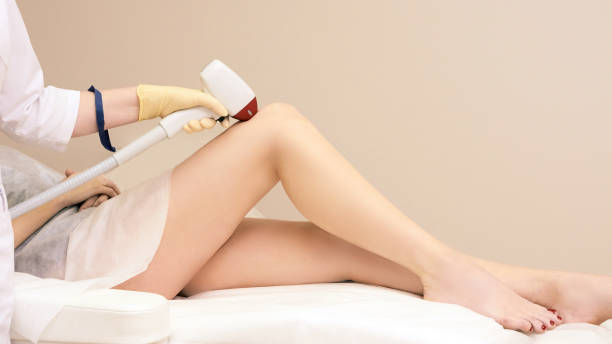Are you tired of constantly shaving, waxing, or plucking unwanted hair? Laser hair removal may be the solution for you. But how long does laser hair removal take? In this comprehensive guide, we will explore everything you need to know about the timeframe for laser hair removal.
What is Laser Hair Removal?
Laser hair removal is a cosmetic procedure that uses laser technology to remove unwanted hair from various parts of the body. The laser targets hair follicles, heating them up and damaging them to prevent future hair growth. The procedure is safe and effective for most people, but it’s important to consult with a licensed professional to determine if you’re a good candidate for laser hair removal.
How Long Laser Hair Removal Takes
The duration of a laser hair removal session can vary based on several factors, including the size of the treatment area, the technology being used, and individual characteristics such as skin type and hair color. On average, a single laser hair removal session can take anywhere from a few minutes to about an hour. Here are some examples of how long laser hair removal can take for different areas of the body:
- Upper lip: 5-10 minutes per session
- Underarms: 15-20 minutes per session
- Bikini area: 30-45 minutes per session
- Legs: 1-2 hours per session
Factors Affecting Treatment Time
Hair Color and Thickness: Dark, coarse hair responds more effectively to laser treatment than light, fine hair. Dark hair absorbs more energy, resulting in a quicker treatment.
Skin Type: Laser hair removal works best on individuals with lighter skin and darker hair. People with darker skin tones may require longer intervals between treatments to avoid potential skin discoloration.
Technology Used: Different types of laser systems have varying spot sizes and pulse durations, which can impact treatment time. Some advanced systems can treat larger areas in a shorter time.
Practitioner Experience: The expertise of the practitioner performing the procedure can influence the speed and effectiveness of the treatment.
Preparation: Following pre-session guidelines provided by the clinic, such as shaving the treatment area before the session, can help streamline the process.
Session Frequency: Multiple sessions are typically required for optimal results. Sessions are usually spaced a few weeks apart to target hair in different growth cycles.
Sensitivity: Individuals with higher pain sensitivity might require breaks during the session.
How Many Laser Treatments Will I Need?
The number of laser hair removal treatments required varies from person to person and depends on several factors, including your skin type, hair color, hair thickness, and the area being treated. On average, most people need around 6 to 8 sessions to achieve optimal results. However, some individuals may require fewer sessions, while others might need more. Here are some key factors that influence the number of laser treatments you’ll need:
Hair Color and Thickness: Dark, coarse hair responds better to laser treatment than light, fine hair. The more contrast there is between your skin tone and hair color, the more effective the treatment is likely to be.
Skin Type: Laser hair removal works best on individuals with lighter skin tones and darker hair. People with darker skin tones might need additional sessions to avoid potential side effects like skin discoloration.
Hair Growth Cycle: Hair grows in different cycles, including anagen (growth phase), catagen (transitional phase), and telogen (resting phase). Laser treatment is most effective during the anagen phase, which is why multiple sessions are required to target hair in different stages of growth.
Area Being Treated: Some areas of the body have denser hair growth than others. Smaller, more concentrated areas may require fewer sessions, while larger areas with more hair may need additional treatments.
Hormonal Factors: Hormonal imbalances or conditions like polycystic ovary syndrome (PCOS) can influence hair growth patterns and may require additional sessions.
Consistency: Adhering to the recommended treatment schedule and attending all scheduled sessions is crucial for optimal results.
Individual Response: How your body responds to the treatment is unique. Some individuals might experience quicker results, while others might require more sessions to achieve the desired outcome.
Tips for Optimal Laser Hair Removal Results
- Avoid tanning before and after the procedure.
- Shave the treatment area beforehand.
- Stay hydrated and moisturized.
- Attend all scheduled sessions.
Following these tips can help maximize the effectiveness of laser hair removal and reduce the risk of complications.
FAQs
- Is laser hair removal permanent? No, laser hair removal is not permanent. However, it can significantly reduce hair growth in the treated areas, leading to smooth, hair-free skin for an extended period. Results vary depending on the individual and may require maintenance sessions to upkeep.
- How many sessions are required for laser hair removal? Most people require between 6-8 sessions spaced several weeks apart to achieve the desired outcome.
- Does laser hair removal hurt? While there may be some mild discomfort during the procedure, most people find it to be tolerable and much less painful than waxing or plucking.
- Can laser hair removal be done on any part of the body? Laser hair removal can be performed on almost any part of the body, including the face, arms, legs, underarms, bikini area, and back.
- How long does recovery take after laser hair removal? There is typically no downtime required after laser hair removal. Some people may experience mild redness and swelling in the treated areas, but this usually subsides within a few hours.
Final Thoughts
In conclusion, laser hair removal is a safe and effective way to remove unwanted hair from various parts of the body. The length of time for the procedure depends on several factors, including the size of the treatment area, your skin type, and the density of your hair. By following some simple guidelines and attending all scheduled sessions, you can achieve smooth, hair-free skin for an extended period. So, if you’re tired of constantly shaving or waxing, laser hair removal may be the solution for you.








